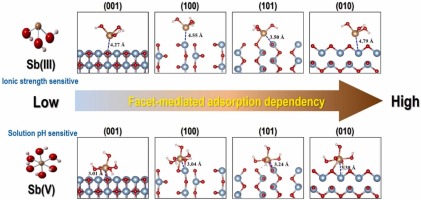Publication
Advanced Redox Technology Lab
Publication
Advanced Redox Technology Lab
Journal papers
In natural environments, the fate and migratory behavior of metalloid contaminants such as antimony (Sb) significantly depend on the interfacial reactivity of mineral surfaces. Although boehmite (γ-AlOOH) is widely observed in (sub)surface environments, its underlying interaction mechanism with Sb oxyanions at the molecular scale remains unclear. Considering Sb-contaminated environmental conditions in this study, we prepared boehmite under weakly acidic conditions for use in the systematic investigation of interfacial interactions with Sb(III) and Sb(V). The as-synthesized boehmite showed a nanorod morphology and comprised four crystal facets in the following order: 48.4% (010), 27.1% (101), 15.0% (001), and 9.5% (100). The combined results of spectroscopic analyses and theoretical calculations revealed that Sb(III) formed hydrogen bonding outer-sphere complexation on the (100), (010), and (001) facets and that Sb(V) preferred to form bidentate inner-sphere complexation via mononuclear edge-sharing configuration on the (100), (001), and (101) facets and binuclear corner-sharing configuration on the (010) facet. These findings indicate that the facet-mediated thermodynamic stability of the surface complexation determines the interaction affinity toward the Sb species. This work is the first to document the contribution of boehmite to (sub)surface media, improving the ability to forecast the fate and behavior of Sb oxyanions at mineral–water interfaces.
